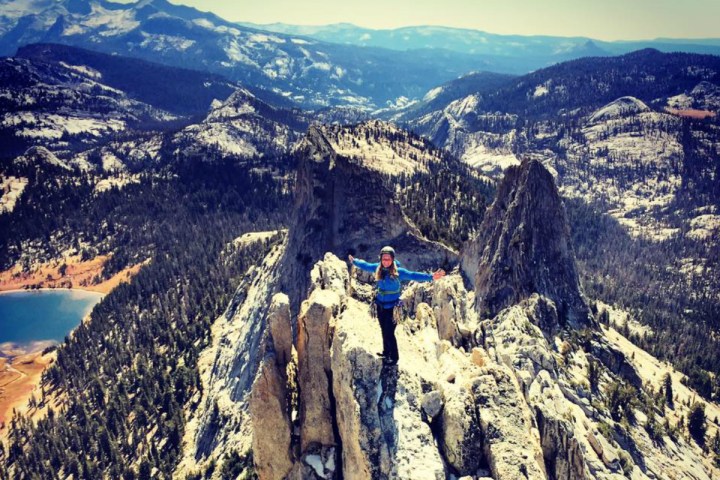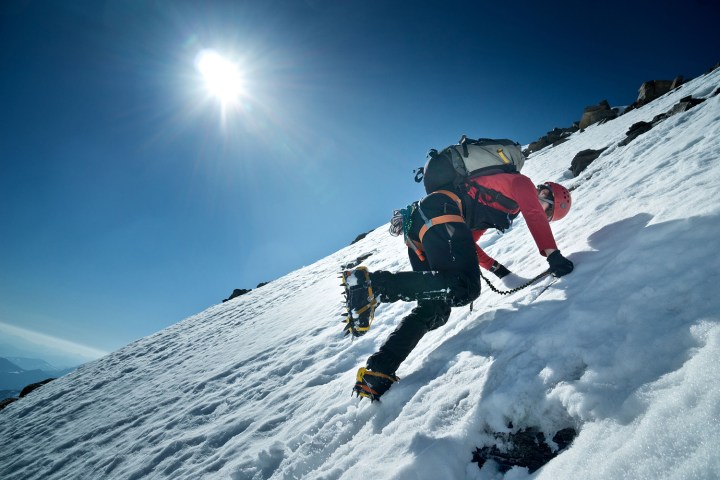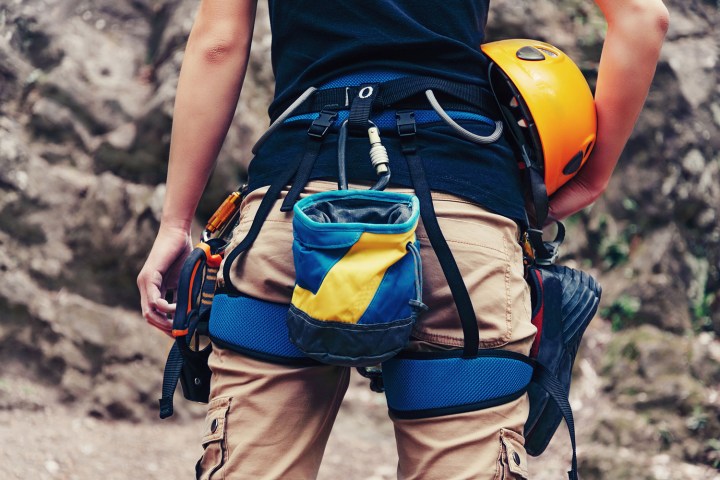
Transitioning from indoor climbing at the gym to outdoor climbing at the crag is a big step but transitioning from outdoor climbing to mountain climbing requires an entirely new set of skills — and a whole new set of gear. It’s important to note that not everyone can start mountaineering tomorrow. While navigating the mountainside may seem a daunting hobby, there’s an abundance of mental and physical rewards.
However, prior to any expedition, there are essential survival skills you must develop such as learning how to crevasse rescue and how to execute roped glacial travel. Seasoned rock climbing knowledge is also incredibly vital — even for lower grade climbs. Although your selected endeavor itself may not include technical climbing, if you find yourself off-route, you may need to know how to climb just to get back on track.
Of course, you won’t learn these skills overnight — they require practice by yourself and with your mountaineering partner or team. If you don’t have the confidence to go off on your own just yet, there are plenty of guide services available for hire. The bottom line: Be prepared and expect the unexpected. Conditions can turn grim on the mountainside faster than anywhere else in the world. With that said, here’s our top essential gear picks for any aspiring mountaineer.

Climbing Pack

Our Pick:
The North Face Summit Series Summit 50L Pack ($240)
Big enough for larger loads yet light enough to scurry across alpine terrain, The North Face meticulously designed this pack with mountaineering in mind. Its unique Fuse Form construction makes for excellent abrasion resistance and since it weighs in at only 41 ounces, it’s hard to find a pack that’s much lighter.
Mountaineering requires the use of a backpack in two different scenarios. One is needed to haul gear to your camp and the other’s for actual climbing — however, there are plenty of single day alpine ascents throughout the United States where setting up a base camp isn’t necessary. It’s certainly possible to utilize the same pack for both base camp and mountain travel on smaller missions, but you must choose wisely.
The most important aspects of selecting a climbing pack for mountaineering include comfort, weight, and the option of a removable frame. While you’re going to need a frame against your back while hiking gear into camp, you might want to remove it on a fast summit push. Aim for purchasing an actual purposed climbing pack as opposed to a backpacking pack. You’re going to want something with a built-in rope, ice axe, and crampon holder.
A lightweight 50L pack is ideal for both hauling gear into camp and traveling up to the summit, though it certainly won’t be full while climbing. Most importantly, make sure the pack is comfortable, fits you correctly, and that the hip straps can be brought around and secured to the back of the pack — again, for climbing’s sake.

Four Season Tent

Our Pick:
Mountain Hardware EV2 ($700)
This tent is built for comfort and strength, featuring a three pole system which provides exceptional protection from the harshest mountain elements. At 83 ounces, the EV2 is much lighter than double wall tents and many other single wall varieties in its class.
Due to the unforgiving nature of the mountainside, your tent should be your biggest investment. It’s your primary protection from the elements and serves as the only thing between you and a massive snowstorm. A mountaineering-specific tent is made for four seasons, designed to withstand brutal winds, and remains capable of warding off excessive precipitation.
Tents come in many shapes and sizes but for a mountain expedition, the key factors to consider are type, strength, winter storm resistance, weight, and ease of set-up. Four season tents come in both double or single wall options. Double wall tents provide two layers of fabric between you and nature, with the inner layer offering increased breathability and the outer layer serving as protection from wind and snow. While double walls are much stronger and provide the best protection, they’re also very pricey and much heavier. There are a number of high-quality single wall tents on the market designed for mountaineering, so it’s not necessary to break the bank — or your back.
Pole design determines the strength of the tent and is the most important aspect to consider. The thickness of the poles, the number of intersections, and how and what they clip to are all important factors. Typically, the thicker the pole the stronger it is but the number of poles and tent design should also be taken into account.
Weight is the third most prominent factor. While four season tents are generally going to be heavier than backpacking tents, you can opt for lighter weight by skimping on unnecessary features such as extra pockets.

Sleeping Bag

Our Pick:
The Mountain Hardware Phantom Torch 3 ($450)
This extremely lightweight bag features 800 down fill and stays incredibly compressible, encompassed by a 10D outer nylon layer. Weighing in at 27.9 ounces, it also boasts an ideal warmth-to-weight ratio which makes this sleeping bag an excellent choice for mountaineers.
A sleeping bag is one of the most coveted pieces of gear on the mountainside as adequate warmth and a good night’s sleep either make or break your expedition. While sleeping bags are constructed from down or synthetic materials, down is your best choice for a mountaineering expedition. Down is significantly warmer than synthetic and most high-end sleeping bags feature a weather resistant outer layer to protect the down from moisture, which renders the insulation useless.
Temperature ratings classify sleeping bags in terms of warmth and for a mountaineering expedition, a minimum rated 0 degree Fahrenheit bag is recommended. The amount of down fill also attributes to the sleeping bag’s warmth while accounting for weight. 750 down fill is the recommended minimum for most winter or high altitude adventures but too much bulk can amount to a heavy weight, so do your research and choose carefully. Some people sleep warmer than others, thus requiring a warmer-rated sleeping bag.

Mountaineering Boots

Our Pick:
La Sportiva’s Trango Cube GT X ($390)
The Trango Cube is the company’s lightest mountaineering boot, offering waterproof protection and a comfortable sole/midsole combination. They can easily be strapped to crampons and are ideal for all-around mountaineering.
Mountaineering boots serve as your lifeline on the mountainside, protection from the elements, and primary mode of transport. Proper fit and warmth are crucial — boot selection remains one of the most important pre-trip decisions. Mountaineering boots range in style depending on technical climbing difficulty but even for low-grade climbs, heel welts for utilizing crampons are essential.
Weight is a determining factor as the heavier the boot, the slower and more tedious the ascent will be, though it is less important than weather resistance or fit. Typical mountaineering boots are stiff, supportive, and waterproof. They should be comfortable and broken in before an expedition, serving for effective utilization across technical terrain.

Crampons

Our Pick:
Black Diamond Sabretooth Crampon ($185)
These crampons are available in both Pro (step-in) and Clip (hybrid) models. They are lightweight stainless steel crampons designed for all-around mountaineering.
Crampons are designed to be strapped onto your mountaineering boots and help you walk or climb across slippery surfaces. It’s important to make sure your crampons fit your boots snugly before starting on an expedition. There are two types of crampons — flexible and rigid. You’ll want to purchase flexible crampons for basic mountaineering, as these bend with your feet and are much more comfortable. They’re also known as “hinged” crampons and are ideal for walking on ice or snow.
There are three different types of crampon attachment systems including step-in, straps, and hybrid. Assuming you purchased boots with heel welts as recommended, the easy attachment hybrid crampons will be your best choice. Hybrid crampons are best utilized with lightweight mountaineering boots, whereas completely step-in crampons are designed to be used with more technical boots.
Strap-on crampons can be used with any kind of mountaineering boot but are much more complicated to secure, and less reliable than hybrid or step-in models. Step-in crampon models can only be used with boots that have both toe and heel welts, which are ideal for more advanced mountaineering and technical ice climbing.

Ice Axe

Our Pick:
Black Diamond Raven Ice Axe ($80)
This is the company’s traditional ice axe, ideal for all-around mountaineering. It’s constructed of aluminum but boasts a stainless steel head and weighs only 15 ounces. For the price, there is no better product on the marketplace.
Some ice axes have spikes on the end of their shafts to better serve for cutting sharply into ice or snow. Choosing the appropriate length of your ice axe is important. The spike or end of the shaft should barely touch the ground when you are standing in a relaxed, upright position.
Ice axes are constructed of either aluminum or stainless steel. Aluminum is lighter but stainless steel is much more durable and effective at penetrating hard ice. For mountaineering purposes, either material will suffice, although aluminum is recommended due to weight considerations.

Stove

Our Pick:
MSR Windburner ($140)
This all-in-one integrated stove and cookware system offers phenomenal wind resistance and an efficient system that quickly brings water to a boil, thus conserving fuel. Easy packing and assembly make it the ideal mountaineering stove.
Unless you’re mountaineering overseas or in the very coldest of conditions, a canister-type fuel stove is perfectly suitable for any mountaineering expedition. Canisters utilize either isobutane or propane fuel, burn cleanly, and come in compact, all-in-one versions.
On an overseas expeditions, canister fuel may be hard to find, and a liquid fuel source is recommended. Since you’ll primarily be boiling snow for water and freeze-dried meals, all-in-one canister models are especially advantageous over screw-on models. Most all-in-one products include an insulated handle which allows for eating directly out of the cookware and are likely to be more stable.

Climbing Rope

Our Pick (Single Rope):
Mammut 9.5 Infinity Dry ($240)
A 9.5-diameter is just thick enough to offer security but light enough to carry comfortably. The Infinity’s high-quality weave makes for easy handling.

Our Pick (Half Rope):
Mammut 8.0 Phoenix Dry ($190)
These ropes are light with a small diameter and dry-treated for alpine pursuits.
For technical terrain and glacier travel, a climbing rope is absolutely necessary. There are many different lengths, diameters, and types of ropes on the market. Static ropes stretch very little and are primarily used in rescue situations but aren’t recommended for climbing. Dynamic ropes are designed to absorb the impact of a fall. Single ropes are utilized primarily for trad climbing, sport climbing, or top-roping, while half ropes are best for mountaineering or ice climbing.
Some ropes are made exclusively for glacier travel but these tend to be smaller in diameter, and aren’t safe enough for technical climbing on their own. For our purposes, let’s assume there’ll be technical climbing on your route. Depending on the expedition, you should bring either two half ropes or a single technical climbing rope. Bringing equipment rated for technical climbing is never a bad idea because you never know exactly what kind of situation you’ll go up against on the mountainside.
The most important aspect to consider is whether or not your rope is weather-treated. For mountaineering purposes where your rope’s exposed to wet elements, a dry-treated rope is necessary. Dry-treated ropes have a dry core, dry sheath, or both, and prevent the rope from absorbing moisture, which can be a safety hazard.
The Union Internationale des Associations d’Alpinisme (UIAA) has enacted standards of safety for climbing ropes. You’ll want to purchase a rope that’s UIAA approved. Other factors to consider include the length and diameter of your rope. For a single technical climbing rope, a diameter of at least 9.5 millimeters is recommended, but anything bigger than a 9.9 isn’t necessary and just weighs you down. Half ropes usually have a diameter between 8 and 9 millimeters. Either 60-meter or 70-meter length ropes are sufficient for mountaineering expeditions. Length selection depends on your route, how much weight you want to carry, and personal preference.

Other climbing gear
Other necessary climbing gear you need to bring on a mountaineering expedition includes a harness, a helmet, and protective equipment including cams, nuts, runners, Prusik cord, a belay/rappel device, ice screws, extra carabiners, and a cordelette. A full rock rack is recommended in addition to ice equipment and as a climber, you should already be familiar with most of the necessary rock climbing equipment from previous outdoor climbing experiences.
There are other optional gear pieces you can consider bringing along. For expeditions with a lot of technical climbing, rock shoes might be desirable so you’ll have the ability to change out of your heavy, clunky mountaineering boots for difficult pitches. You might want a chalk bag as well — especially in wet conditions — in order to dry your hands.
Other outdoor gear
On your expedition, you’ll likely be living off-the-grid for a period of time. Accessories you need to bring include: A headlamp, first aid kit, small knife or multi-tool, eating utensils, water treatment, compass, map, guidebook, toilet paper, sanitation shovel, fuel, food, and clothes. Your clothes should comprise base layers, mid layers, socks, a down or synthetic puff coat, rain shell and pants, gloves, and a hat. Wool socks and base layers are recommended for odor resistance and your gloves should be warm and waterproof but provide enough dexterity to wield an ice axe or to belay a partner. Optional high-tech accessories include a GPS system, avalanche transceiver, or two-way radio.
Mountaineering is one of the most rewarding hobbies in the world but shouldn’t be taken lightly. Spend time developing essential rescue skills and learn how to effectively use your gear before setting out. Being properly prepared is the key to success in the mountains.


